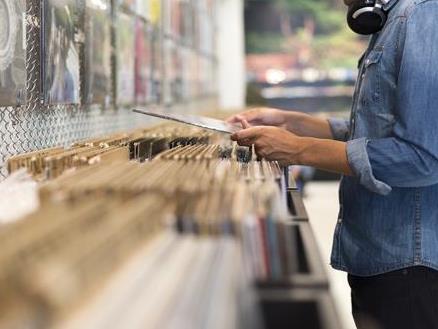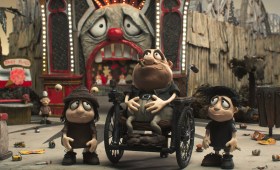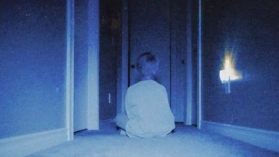Image via Shutterstock
Currently, the only two growth areas in the music industry are in digital streaming services and, ironically, its antithesis: vinyl records. Large, fragile records, wrapped in tissue paper and cardboard sleeves, adorned with carefully selected album art and then stored on a shelf were once thought to be redundant.
But sales of vinyl have been on the rise for the past decade. Last year, vinyl sales worldwide were the highest they’ve been in 25 years. In Australia, vinyl represents almost 15% of all physical music sales. This is huge for a format that, in convenience, durability and price, is inferior to the CD and the MP3.
2016 Australian sales statistics will be released by ARIA later this month, but are expected to follow the upward trend after jumping 38% from 2014 to 2015, and a huge 127% from 2013 to 2014.
Vinyl is expensive – a typical album costs around the $40 mark, compared with $10 for a CD or a streaming subscription that, if you listen to only one album a week, averages about $3. Consumers are willing to pay much more: Beatles, Bowie and Rolling Stones special editions push north of $500.
The thirst for vinyl is part of a wider nostalgia trend. Despite predictions that digital technology would make many analogue functions obsolete, sales of hard copy books, board games and analogue wristwatches are growing. The fashion is certainly not about function: these technologies have been superseded many times over, with versions that offer a better, cleaner and cheaper user experience.
So why do people still buy records? Often, it is for the same reason many people still read books on paper: it just feels better.
In a reaction against the digital world, there is a yearning for tangible, well-made products. Even the fact that vinyl is delicate, scratches easily and needs to be stored carefully makes it ironically appealing in a world where everything else is disposable or electronic.
‘It’s almost like it’s part of the craft/handmade/ye olde worlde movement which is concerned with classic forms and objects made the old fashioned way, rather than mass-produced, spat out objects that are made as cheaply and expediently as industrially and technologically possible,’ said Paul Rigby, the co-owner of Australia’s only vinyl-pressing company, Zenith Records in Brunswick.
Then there are the audiophiles who swear it sounds better. ‘The audio playback, which, on a decent sound system, can make the music sound a lot more “warmer” and “full”,’ said Tom Barkl, label co-ordinator at indie label Future Classic. ‘This is because you’re using an analogue method to listen to decompressed music, the highs and lows in the waveform seem crisper to the ear. Most vinyl buyers purchase records knowing that’ll sound better than streaming off Spotify: 1411kbps vs 128kbps, 11x times better!’
Spin me right round
Read: You can make money on Spotify
The “collectability” of records is another reason for the uptick in sales. Having a collection of 8,000 albums on Spotify is not unusual, but having a collection of 8,000 LPs is not to be sniffed at. And in a time when you can often no longer touch or see your music collection, short of scrolling through an app, the actual physicality of the music is important. ‘The tangibility of records is definitely driving the surge. People love displaying the cover arts, having them as a fan/collector’s item, having the exclusive content (bonus tracks, artworks etc),’ said Barkl.
Like lining your shelves with unread but impressive books, collecting and displaying vinyl is as important as the music itself. In fact a UK poll for the BBC last year revealed that of the people who bought a record in the past month, 48% have yet to play it – and 7% of those don’t even own a turntable. Student Jordan Katende told the BBC: ‘I have vinyls in my room but it’s more for decor. I don’t actually play them. It gives me the old-school vibe. That’s what vinyl’s all about.’
LPs are a collectable item, said Rigby. ‘With CDs and digital media becoming increasingly devalued over the years, the desirability of the classic LP format as a means to purchase music has struck a chord with a new generation of music fans as a collectable item, a keepsake that stands a good chance of appreciating in value over the years and a discovery of a new approach and ritual to playing music.’
‘No longer a playlist of mashed up tunes, the album demands that the object is carefully placed on the turntable, cleaned with a brush and the stylus dropped with care into the lead in groove – that the magic is happening before one’s very eyes (not enclosed in hidden in a disc drive) I think also holds some allure and mystique,’ said Rigby.
With some music fans concerned that their favourite artists may not be receiving adequate royalties from streaming services, vinyl is another way to support the artist. ‘There are many theories as to why vinyl is enjoying a renaissance, one of which is that music fans do want to support artists and musicians they like,’ said Rigby.
Instead of one replacing the other, Rigby believes that streaming and vinyl complement each other well. ‘The streaming aspect of music delivery has been shown to benefit purchases of vinyl records as customers can now “try before they buy” so they can access and listen to music via streams and actually purchase the albums they like on vinyl.
Reactionary records
Read: Are artists making money from streaming?
So why do some analogue technologies stick around, while others simply disappear? It’s hard to imagine a renewed interest in VHS tapes, or dial-up telephones. But like mid-century furniture and vintage clothing, retromania has led to a nostalgic view of the days before online banking, hashtags and self-checkout machines.
The types of music being sold on vinyl gives an insight into the resurgence. In the UK, last year’s top five selling albums on vinyl were David Bowie’s Blackstar, Amy Winehouse’s Back to Black, the Guardians of the Galaxy soundtrack, Radiohead’s A Moon Shaped Pool and Fleetwood Mac’s classic Rumours.
Vintage albums by The Stone Roses, Bob Marley, The Beatles, Prince and Nirvana rounded out the top ten.
Australia doesn’t chart LP sales yet, but anecdotal evidence is that local results would be similar. ‘Some of the bestselling titles on vinyl are from indie and alternative artists, as well as old school and classics such as The Rolling Stones, The Beatles and Michael Jackson,’ said Rigby. Owning an album on the same format that it was released on forty or fifty years ago is perhaps seen as more genuine than simply streaming the songs online.
The majority of vinyl buyers in the past ten years were people under 30, who have fond memories of their parents’ records, said Rigby. ‘They’ve not grown up with vinyl as the standard medium – the quirks, flaws and aspects of inconvenience of vinyl records and turntables that dogged previous generations who embraced CDs for their simplicity of use.’
And to come full circle, the older generation are now buying back the vinyl that they got rid of in the first place. ‘The last two to three years have seen more growth in the older generation who grew up with vinyl re-embracing the format,’ said Rigby. The interesting thing is that this generation traded their old LPs in for CDs when CDs became the standard, and now they’ve re-entered the market being able to purchase reasonably priced new turntables and a plethora of reissued titles becoming available once again in vinyl format, often remastered and sounding much better than the original records they remembered.’
Press on
Read: New grants program music to neighbours’ ears
The vinyl boom means pressing plants around the world are finding new work. The biggest plants, in the Czech Republic, France and the US, never shut, but more are popping up worldwide. Zenith Records moved to larger premises three years ago to cope with demand. ‘Vinyl manufacturing is a very long, long process,’ said Rigby. ‘Many pressing plants are seeing the vinyl surge as just a phase and no one has the confidence to open more warehouses.
‘What this means is that every pressing plant in the world is at full speed and the demand is at all-time high. Once you have all the parts for your record you are put at the back of a queue which can take 4 months receive your final product.’
Despite the long turnaround, bands and musicians are scrambling to get their music printed on vinyl. The process can be costly for bands, which is why records cost an average of $40. The process is arduous and time consuming, and involves formatting the masters and cutting them into an acetate or lacquer plate, which are then placed onto the presses. ‘These plates are trimmed, polished and formed so that they go on to our presses. We then make test pressings for the customers to listen to and evaluate, ensuring the music sounds as they expect and that there are no flaws in the plates,’ said Rigby. Once the test presses are approved, the final copies are created, special labels are added, then the records are placed in their sleeves, packed and shipped.
Rigby said that some customers want to keep the process entirely analogue. ‘We have had some call for cutting masters from tape, rather than a digital source, as there are analogue purists who seek to keep the process completely digital free. We were lucky to find a tape machine specifically built for cutting acetates from tape mid-last year and are in the process of refurbishing this machine so that we can in fact offer a complete analogue mastering and cutting service for customers who want this.’
With completely analogue mastering, pressing on machines from the 70s, and a return to buying music for the sound, not the convenience, it’s an exciting time to collect a technology that’s more than a century old.





